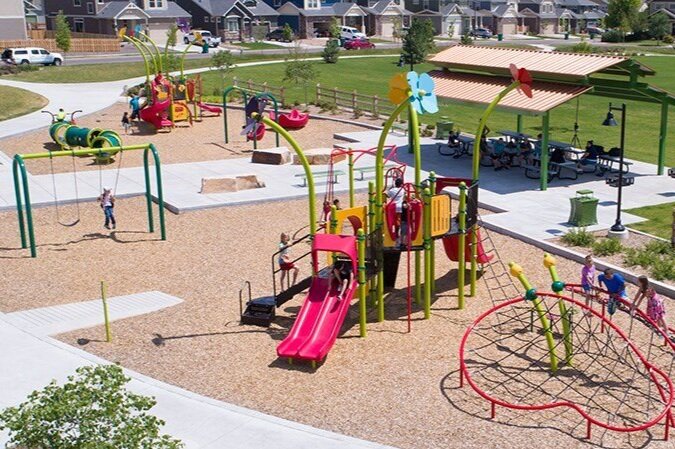As aquatic facilities plan to reopen for summer, they may look to make improvements for even more fun experiences at their pools and splash pads. Some may seek to address safety concerns like slip-and-falls. Others may look to enhance design and play value. Many of the solutions offered by Life Floor can help achieve these goals. Learn more about some easy ways our surfacing can address these needs in time for summer.
1. IMPROVE FACILITY SAFETY
Some of the most common pain points we hear involve slippery, abrasive surfaces that are difficult to maintain. These problems often lead to unfortunate injuries or increased risk at facilities.
We're also often contacted by customers that have tried other safety surfacing solutions that have failed in an aquatic environment. Many other rubberized or aggregate materials have been designed for dry playgrounds. As a result, they aren't engineered to withstand the unique combination of UV, aquatic, and chemical impacts that face splash pads or pool decks.
Other customers have struggled with growth on the surfacing at their facilities. Unlike more porous options, Life Floor features a closed-cell technology, which doesn’t foster growth of bacteria, mold, and algae. Our tiles have been third-party tested for cleanability and offer a great solution for anyone who has experienced this issue.
In 2019, NSF International passed NSF/ANSI/CAN Standard 50:26 outlining criteria for safety surfacing products for interactive water play, which include slip-resistance and cushioning among others. They recognize that similar safety parameters are needed in aquatic play areas, following the precedent set by dry playgrounds. Life Floor is the first and currently only product to be certified to this standard.
Our tiles can be easily installed over existing substrates to address safety concerns or to replace other surfacing solutions that have failed. If you have an existing facility where Life Floor might be a good fit, contact us to learn more.
2. BRIGHTEN UP SURFACING DESIGN
Many aquatic facilities contact Life Floor in need of a bright, new refresh. Adding our colorful tiles can transform any area with a blank, monochromatic surface to create an engaging, immersive experience for guests of all ages.
Our thematic Inlays can be easily integrated into any design to increase play value, theming, and visual interest. Games and graphics can also be included as part of a Life Floor installation. For budget-conscious or simpler designs, our preset Themes and Patterns can achieve beautiful results without the added costs of custom work.
3. CUSHION WATER SLIDE LANDINGS
We often hear from customers in search of new or improved cushioning at water slide landings. In many ways, prior solutions they've tried have fallen short. For instance, traditional slide landing pads are made with an impervious shell that has a consistent flaw in design; the cushioning and the waterproofing are viewed as separate elements. After repeated impact as guests exit a slide, the protective shell often fails leaving the padding exposed to water. From there, traditional landing pads can grow mold, the sharp edges of the failed protective shell can cause injuries, and pieces of foam can leak into the pool during peak busy season. These traditional landing pads are also typically bolted down to the pool bottom, which can result in tripping hazards or injuries during slide exits.
With Life Floor, our product’s inherent non-absorbent and impact cushioning qualities are built into our landing pads: no coatings, protective shells, or bolts required. Instead of bolts, Life Floor Landing Pads are adhered to the pool bottom with construction-grade, solvent-based contact cement, which can be found at a local hardware or flooring supply store.
Each Life Floor Landing Pad has a 4 ft (121.92 cm) critical fall height, 5-year material warranty, and non-abrasive slip-resistance for a safer exit every time. Our landing pads are created out of modular 2 ft (60.96 cm) square tiles so they can be customized to fit anywhere operators need to install them. In the event that any damage ever occurs, our modular design allows for only the compromised tiles to be replaced, which helps save on overall cost.
Life Floor Landing Pads are a great way to test out our products at your facility for a relatively low price point. To order one of our Landing Pads today, visit our online storefront here.
RETROFITTING LIFE FLOOR
One of the most common questions we get asked is, “Can Life Floor be installed over an existing surface?” The answer is yes! This type of installation, also known as a retrofit installation, is extremely common. Life Floor can be installed over virtually any solid substrate such as concrete or ceramic tile. When our installers are working with an existing surface, they will often prepare the surface beforehand by patching any cracks and grinding the surface down to ensure a smooth surface before laying Life Floor tiles.
If any spray features are present at the installation site or if there is a concrete apron surrounding the aquatic zone, our installers will use transition strips to provide a cohesive experience and ensure tripping hazards are eliminated. Our installation teams work to perfectly surround any spray features without removing them to reduce maintenance downtime and ensure a snug fit.
Transition strips help simplify the process by creating a seamless transition from the surrounding area onto the aquatics feature zone. Life Floor transition strips are ADA Compliant and provide a smooth ramp onto the installation that prevents stubbed toes and accessibility concerns.
With proper preparation and the right team of installers, Life Floor can easily surface over existing substrates to transform facilities with improved safety and design. Our team always enjoys hearing from customers who have seen the impact that our tiles have made.
If you’re interested in retrofitting your splash pad or pool deck with Life Floor, we'd love to support your needs in time for your summer reopening. Be sure to request a quote and see what a difference beautifully designed safety surfacing can make.












